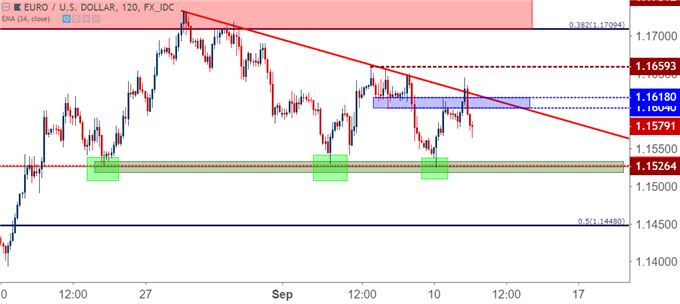
EUR/USD BACK-BELOW 1.1600 AS PRICES BUILD INTO DESCENDING TRIANGLE
It’s been a pensive past couple of weeks for EUR/USD. After opening August by selling-off down to fresh lows, driven by fears around European banks’ exposure to Turkey, EUR/USD caught support mid-month and then spent the next two weeks erasing a large portion of those losses. Resistance eventually showed around the same 1.1709-1.1750 area that had held the highs in July, and since then we’ve had a bit of back-and-forth price action.
With support showing around 1.1525-1.1530 combined with the lower-highs that have continued to print, we now have a short-term descending triangle formation. This type of formation will often be approached in a bearish manner, expecting the increasing motivation from sellers coming in at lower-highs to eventually break below the horizontal support that’s developed.
EUR/USD TWO-HOUR PRICE CHART: LOWER-HIGHS WITH HORIZONTAL LOWS CREATES DESCENDING TRIANGLE

Chart prepared by James Stanley
On a bigger-picture basis, that support around 1.1530 has been at work for some time, including a large chunk of this summer. This is where support had finally showed-up after the brutal move in April and the month of May. This price held the lows through multiple downside tests, including the ECB’s June rate decision in which they announced stimulus taper while warning that rates would stay at current levels ‘at least through the summer of 2019.’
This level didn’t give way until early-August. This is when jitters around European banks’ exposure to Turkey was creating considerable risk aversion. But life below 1.1525 didn’t last long, as EUR/USD had recovered back-above this price just a week-and-a-half later, and has since put in three additional support tests while holding the lows in the pair.
EUR/USD EIGHT-HOUR PRICE CHART: WELCOME BACK, 1.1530

Chart prepared by James Stanley
ECB ON DECK – WILL THEY ANNOUNCE STIMULUS TAPER?
This Thursday brings a big ECB meeting as the bank is expected to begin whittling down bond purchases. This speaks to a theme that’s brought significant drama over the past year, as the prospect of stimulus exit and eventual higher rates helped to drive the single currency higher throughout last year and into the early portion of 2018.
















